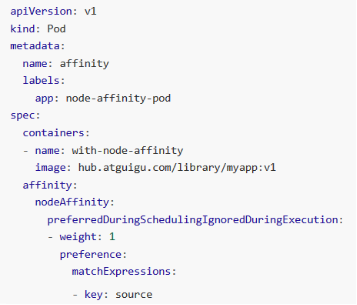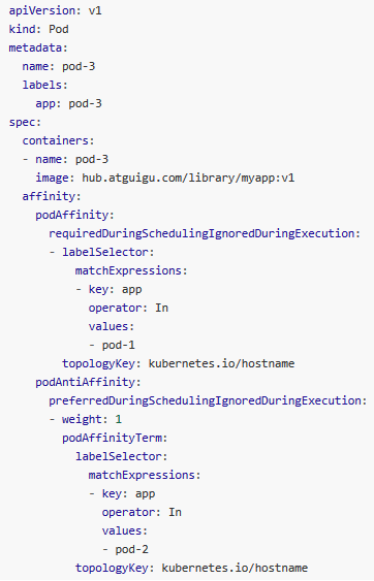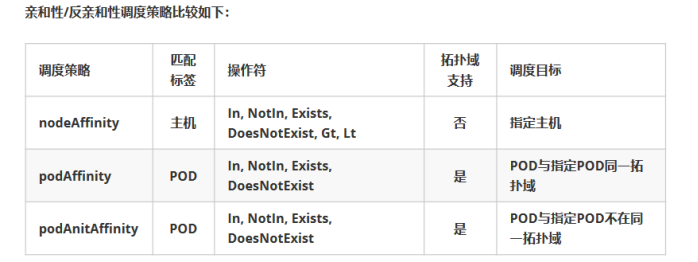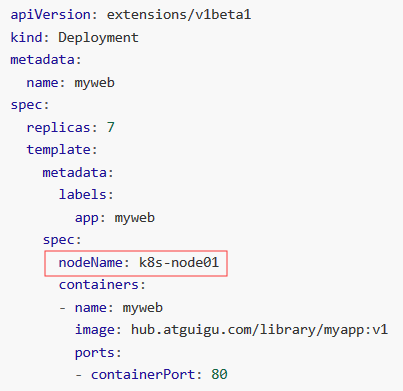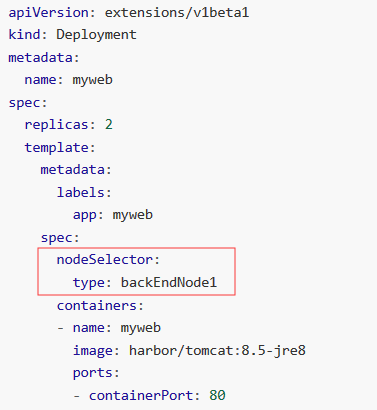第十五章 Kubernetes调度器
一、简介
Scheduler 是 kubernetes 的调度器,主要的任务是把定义的 pod 分配到集群的节点上。听起来非常简单,但有很多要考虑的问题:
① 公平:如何保证每个节点都能被分配资源
② 资源高效利用:集群所有资源最大化被使用
③ 效率:调度的性能要好,能够尽快地对大批量的 pod 完成调度工作
④ 灵活:允许用户根据自己的需求控制调度的逻辑
Scheduler 是作为单独的程序运行的,启动之后会一直坚挺 API Server,获取PodSpec.NodeName为空的 pod,对每个 pod 都会创建一个 binding(必须遵守的),表明该 pod 应该放到哪个节点上
二、调度过程
调度分为几个部分:
1) 首先是过滤掉不满足条件的节点,这个过程称为predicate(预选);
2) 然后对通过的节点按照优先级排序,这个是priority(优选);
3) 最后从中选择优先级最高的节点。
如果中间任何一步骤有错误,就直接返回错误(先预选,后优选)
Predicate(预选)有一系列的算法可以使用:
① PodFitsResources:节点上剩余的资源是否大于 pod 请求的资源
② PodFitsHost:如果 pod 指定了 NodeName,检查节点名称是否和 NodeName 匹配
③ PodFitsHostPorts:节点上已经使用的 port 是否和 pod 申请的 port 冲突
④ PodSelectorMatches:过滤掉和 pod 指定的 label 不匹配的节点
⑤ NoDiskConflict:已经 mount 的 volume 和 pod 指定的 volume 不冲突,除非它们都是只读
如果在 predicate 过程中没有合适的节点,pod 会一直在pending状态(pending:等待),不断重试调度,直到有节点满足条件。经过这个步骤,如果有多个节点满足条件,就继续 priorities 过程:按照优先级大小对节点排序
优先级由一系列键值对组成,键是该优先级项的名称,值是它的权重(该项的重要性)。这些优先级选项包括:
LeastRequestedPriority:通过计算 CPU 和 Memory 的使用率来决定权重,使用率越低权重越高。换句话说,这个优先级指标倾向于资源使用比例更低的节点
BalancedResourceAllocation:节点上 CPU 和 Memory 使用率越接近,权重越高。这个应该和上面的一起使用,不应该单独使用
ImageLocalityPriority:倾向于已经有要使用镜像的节点,镜像总大小值越大,权重越高
通过算法对所有的优先级项目和权重进行计算,得出最终的结果
三、自定义调度器
除了 kubernetes 自带的调度器,你也可以编写自己的调度器。通过spec:schedulername参数指定调度器的名字,可以为 pod 选择某个调度器进行调度。比如下面的 pod 选择my-scheduler进行调度,而不是默认的default-scheduler:
|
apiVersion: v1 kind: Pod metadata: name: annotation-second-scheduler labels: name: multischeduler-example spec: schedulername: my-scheduler containers: - name: pod-with-second-annotation-container image: gcr.io/google_containers/pause:2.0 |
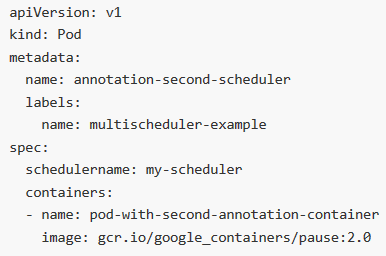
|
四、节点亲和性(pod与node的亲和性)
|
pod.spec.nodeAffinity preferredDuringSchedulingIgnoredDuringExecution(优先执行计划):软策略 requiredDuringSchedulingIgnoredDuringExecution(要求执行计划):硬策略 preferred:首选,较喜欢 required:需要,必修 |
|
|
requiredDuringSchedulingIgnoredDuringExecution #节点硬策略。排除node02,只能在node01上运行 apiVersion: v1 kind: Pod metadata: name: affinity labels: app: node-affinity-pod spec: containers: - name: with-node-affinity image: hub.atguigu.com/library/myapp:v1 affinity: #亲和性 nodeAffinity: #node亲和性 requiredDuringSchedulingIgnoredDuringExecution: nodeSelectorTerms: - matchExpressions: - key: kubernetes.io/hostname operator: NotIn #键值运算关系 ,NotIn:label的值不在某个列表中 values: - k8s-node02 |
Terms:条件 matchExpressions:匹配表达式 operator:操作人员 |
|
preferredDuringSchedulingIgnoredDuringExecution #r软策略 apiVersion: v1 kind: Pod metadata: name: affinity labels: app: node-affinity-pod spec: containers: - name: with-node-affinity image: hub.atguigu.com/library/myapp:v1 affinity: nodeAffinity: preferredDuringSchedulingIgnoredDuringExecution: - weight: 1 #权重,权重越大越亲和(多个软策略的情况) preference: matchExpressions: - key: source operator: In values: - qikqiak 查看:kubectl get node --show-labels |
|
|
合体
apiVersion: v1 kind: Pod metadata: name: affinity labels: app: node-affinity-pod spec: containers: - name: with-node-affinity image: hub.atguigu.com/library/myapp:v1 affinity: nodeAffinity: requiredDuringSchedulingIgnoredDuringExecution: nodeSelectorTerms: - matchExpressions: - key: kubernetes.io/hostname operator: NotIn values: - k8s-node02 preferredDuringSchedulingIgnoredDuringExecution: - weight: 1 preference: matchExpressions: - key: source operator: In values: - qikqiak |

|
键值运算关系
① In:label 的值在某个列表中
② NotIn:label 的值不在某个列表中
③ Gt:label 的值大于某个值
④ Lt:label 的值小于某个值
⑤ Exists:某个 label 存在
⑥ DoesNotExist:某个 label 不存在
五、Pod 亲和性(pod与pod之间的亲和性)
|
pod.spec.affinity.podAffinity/podAntiAffinity l preferredDuringSchedulingIgnoredDuringExecution:软策略 l requiredDuringSchedulingIgnoredDuringExecution:硬策略 |
|
|
apiVersion: v1 kind: Pod metadata: name: pod-3 labels: app: pod-3 spec: containers: - name: pod-3 image: hub.atguigu.com/library/myapp:v1 affinity: podAffinity: requiredDuringSchedulingIgnoredDuringExecution: - labelSelector: matchExpressions: - key: app operator: In values: - pod-1 topologyKey: kubernetes.io/hostname podAntiAffinity: preferredDuringSchedulingIgnoredDuringExecution: - weight: 1 podAffinityTerm: labelSelector: matchExpressions: - key: app operator: In values: - pod-2 topologyKey: kubernetes.io/hostname |
|
|
亲和性/反亲和性调度策略比较如下: |
|
六、Taint 和 Toleration
节点亲和性,是pod的一种属性(偏好或硬性要求),它使pod被吸引到一类特定的节点。Taint 则相反,它使节点能够排斥一类特定的 pod
Taint 和 toleration 相互配合,可以用来避免 pod 被分配到不合适的节点上。每个节点上都可以应用一个或多个taint ,这表示对于那些不能容忍这些 taint 的 pod,是不会被该节点接受的。如果将 toleration 应用于 pod上,则表示这些 pod 可以(但不要求)被调度到具有匹配 taint 的节点上
1、污点 ( Taint ) 的组成
使用kubectl taint命令可以给某个 Node 节点设置污点,Node 被设置上污点之后就和 Pod 之间存在了一种相斥的关系,可以让 Node 拒绝 Pod 的调度执行,甚至将 Node 已经存在的 Pod 驱逐出去每个污点的组成如下:
|
key=value:effect |
每个污点有一个 key 和 value 作为污点的标签,其中 value 可以为空,effect 描述污点的作用。当前 taint effect 支持如下三个选项:
NoSchedule:K8Snode添加这个effecf类型污点,新的不能容忍的pod不能再调度过来,但是老的运行在node上不受影响
NoExecute:K8Snode添加这个effecf类型污点,新的不能容忍的pod不能调度过来,老的pod也会被驱逐
PreferNoSchedule:pod会尝试将pod分配到该节点
2、污点的设置、查看和去除
#查看节点污点 kubectl describe node node-name # 设置污点 kubectl taint nodes node1 key1=value1:NoSchedule # 节点说明中,查找 Taints 字段 kubectl describe pod pod-name # 去除污点 kubectl taint nodes node1 key1=value1:NoSchedule-
pod设置容忍一个污点
apiVersion: apps/v1Beta1 kind: Deployment metadata: name: nginx-deploy spec: replicas: 1 selector: matchLabels: app: nginx template: metadata: labels: app: nginx spec: containers: - name: nginx images: nginx:laste ports: - containerPort: 80 tolerations: #containers同级 - key: "key1" #能容忍的污点key operator: "Equal" #Equal等于表示key=value , Exists不等于,表示当值不等于下面value正常 value: "value1" #值 effect: "NoExecute" #effect策略,见上面 tolerationSeconds: 3600 #原始的pod多久驱逐,注意只有effect: "NoExecute"才能设置,不然报错
七、容忍(Tolerations)
设置了污点的 Node 将根据 taint 的 effect:NoSchedule、PreferNoSchedule、NoExecute 和 Pod 之间产生互斥的关系,Pod 将在一定程度上不会被调度到 Node 上。但我们可以在 Pod 上设置容忍 ( Toleration ) ,意思是设置了容忍的 Pod 将可以容忍污点的存在,可以被调度到存在污点的 Node 上
|
pod.spec.tolerations
tolerations: - key: "key1" operator: "Equal" value: "value1" effect: "NoSchedule" tolerationSeconds: 3600 - key: "key1" operator: "Equal" value: "value1" effect: "NoExecute" - key: "key2" operator: "Exists" effect: "NoSchedule" |
|
|
l 其中 key, vaule, effect 要与 Node 上设置的 taint 保持一致 l operator 的值为 Exists 将会忽略 value 值 l tolerationSeconds 用于描述当 Pod 需要被驱逐时可以在 Pod 上继续保留运行的时间 |
|
1、当不指定 key 值时,表示容忍所有的污点 key:
|
tolerations: - operator: "Exists" |
2、当不指定 effect 值时,表示容忍所有的污点作用
|
tolerations: - key: "key" operator: "Exists" |
3、有多个 Master 存在时,防止资源浪费,可以如下设置
|
kubectl taint nodes Node-Name node-role.kubernetes.io/master=:PreferNoSchedule |
配置节点故障后Pod重新调度的时间
例如下面的配置文件,对于notReady和unreachable状态的节点,其上的Pod等待300秒,如果仍未恢复,则会停止执行。

八、指定调度节点
1、Pod.spec.nodeName 将 Pod 直接调度到指定的 Node 节点上,会跳过 Scheduler 的调度策略,该匹配规则是强制匹配
|
apiVersion: extensions/v1beta1 kind: Deployment metadata: name: myweb spec: replicas: 7 template: metadata: labels: app: myweb spec: nodeName: k8s-node01 containers: - name: myweb image: hub.atguigu.com/library/myapp:v1 ports: - containerPort: 80 |
|
2、Pod.spec.nodeSelector:通过 kubernetes 的 label-selector 机制选择节点,由调度器调度策略匹配 label,而后调度 Pod 到目标节点,该匹配规则属于强制约束
|
apiVersion: extensions/v1beta1 kind: Deployment metadata: name: myweb spec: replicas: 2 template: metadata: labels: app: myweb spec: nodeSelector: type: backEndNode1 containers: - name: myweb image: harbor/tomcat:8.5-jre8 ports: - containerPort: 80 |
|

链接:
https://www.cnblogs.com/cocowool/p/taints_and_tolerations.html
https://www.bilibili.com/video/av66617940/?p=58
NoExecute:K8Snode添加这个effecf类型污点,新的不能容忍的pod不能调度过来,老的pod也会被驱逐


